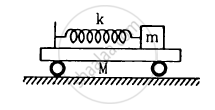Advertisements
Advertisements
प्रश्न
A particle executes simple harmonic motion with an amplitude of 10 cm and time period 6 s. At t = 0 it is at position x = 5 cm going towards positive x-direction. Write the equation for the displacement x at time t. Find the magnitude of the acceleration of the particle at t = 4 s.
उत्तर
It is given,
Amplitude of the simple harmonic motion, A =10 cm
At t = 0 and x = 5 cm,
Time period of the simple harmonic motion, T = 6 s
Angular frequency (ω) is given by,
\[\omega = \frac{2\pi}{T} = \frac{2\pi}{6} = \frac{\pi}{3} \sec^{- 1}\]
Consider the equation of motion of S.H.M,
Y = Asin \[\left( \omega t + \phi \right)\]...(1)
where Y is displacement of the particle, and \[\phi\] is phase of the particle.
On substituting the values of A, t and ω in equation (1), we get:
5 = 10sin(ω × 0 + ϕ)
\[\Rightarrow\] 5 = 10sin ϕ
\[\sin \phi = \frac{1}{2}\]
\[ \Rightarrow \phi = \frac{\pi}{6}\]
∴ Equation of displacement can be written as,
\[x = \left( 10 \text { cm }\right) \sin \left( \frac{\pi}{3}t + \frac{\pi}{6} \right)\]
(ii) At t = 4 s,
\[x = 10\sin\left[ \frac{\pi}{3}4 + \frac{\pi}{6} \right]\]
\[ = 10\sin\left[ \frac{8\pi + \pi}{6} \right]\]
\[ = 10\sin\left( \frac{9\pi}{6} \right)\]
\[ = 10\sin\left( \frac{3\pi}{2} \right)\]
\[ = 10\sin\left( \pi + \frac{\pi}{2} \right)\]
\[ = - 10\sin\frac{\pi}{2} = - 10\]
Acceleration is given by,
a = −ω2x
\[= \left( \frac{- \pi^2}{9} \right) \times \left( - 10 \right)\]
\[ = 10 . 9 \approx 11 \text { cm }/ \sec^{- 2}\]
APPEARS IN
संबंधित प्रश्न
It is proposed to move a particle in simple harmonic motion on a rough horizontal surface by applying an external force along the line of motion. Sketch the graph of the applied force against the position of the particle. Note that the applied force has two values for a given position depending on whether the particle is moving in positive or negative direction.
A block of known mass is suspended from a fixed support through a light spring. Can you find the time period of vertical oscillation only by measuring the extension of the spring when the block is in equilibrium?
The displacement of a particle in simple harmonic motion in one time period is
The average energy in one time period in simple harmonic motion is
Suppose a tunnel is dug along a diameter of the earth. A particle is dropped from a point, a distance h directly above the tunnel. The motion of the particle as seen from the earth is
(a) simple harmonic
(b) parabolic
(c) on a straight line
(d) periodic
For a particle executing simple harmonic motion, the acceleration is proportional to
In a simple harmonic motion
All the surfaces shown in figure are frictionless. The mass of the care is M, that of the block is m and the spring has spring constant k. Initially the car and the block are at rest and the spring is stretched through a length x0 when the system is released. (a) Find the amplitudes of the simple harmonic motion of the block and of the care as seen from the road. (b) Find the time period(s) of the two simple harmonic motions.

A pendulum having time period equal to two seconds is called a seconds pendulum. Those used in pendulum clocks are of this type. Find the length of a second pendulum at a place where g = π2 m/s2.
The angle made by the string of a simple pendulum with the vertical depends on time as \[\theta = \frac{\pi}{90} \sin \left[ \left( \pi s^{- 1} \right)t \right]\] .Find the length of the pendulum if g = π2 m2.
A pendulum clock giving correct time at a place where g = 9.800 m/s2 is taken to another place where it loses 24 seconds during 24 hours. Find the value of g at this new place.
A closed circular wire hung on a nail in a wall undergoes small oscillations of amplitude 20 and time period 2 s. Find (a) the radius of the circular wire, (b) the speed of the particle farthest away from the point of suspension as it goes through its mean position, (c) the acceleration of this particle as it goes through its mean position and (d) the acceleration of this particle when it is at an extreme position. Take g = π2 m/s2.
A particle is subjected to two simple harmonic motions of same time period in the same direction. The amplitude of the first motion is 3.0 cm and that of the second is 4.0 cm. Find the resultant amplitude if the phase difference between the motions is (a) 0°, (b) 60°, (c) 90°.
A simple pendulum is suspended from the roof of a school bus which moves in a horizontal direction with an acceleration a, then the time period is
Define the frequency of simple harmonic motion.
Write short notes on two springs connected in parallel.
The displacement of a particle is represented by the equation `y = 3 cos (pi/4 - 2ωt)`. The motion of the particle is ______.
The displacement of a particle varies with time according to the relation y = a sin ωt + b cos ωt.
Motion of a ball bearing inside a smooth curved bowl, when released from a point slightly above the lower point is ______.
- simple harmonic motion.
- non-periodic motion.
- periodic motion.
- periodic but not S.H.M.
